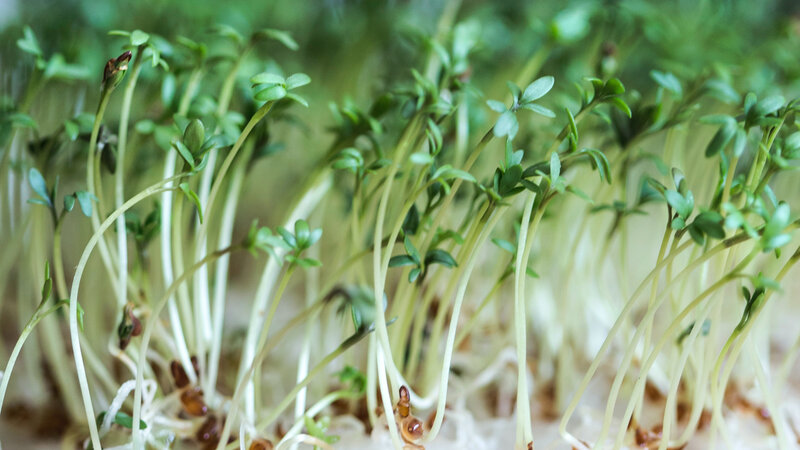Sprouted foods, or sprouts, are the grains, seeds, and legumes that started the process of creating a new plant. The grains and seeds of a certain plant are true concentrations of nutrients, and in a certain way "dormant" and waiting for the ideal conditions to develop. When we give them water, oxygen and a certain temperature, this food starts different biochemical processes that have the purpose of creating a new plant.
These are extremely nutritious and beneficial for health. These foods are increasingly present in the diet of the population, since they provide many vitamins that we all need. The sprouts are the seeds a little more developed, when the root grows and the first leaves are formed. And the hydroponic cultivation of these cultures is very simple.
A positive point in growing sprouts, mainly in urban environments, is that producing them requires little space. Furthermore, such cultivation requires low investment, simple technologies and the final product is obtained quickly. The high yield is another advantageous aspect, since 1 kg of seeds can produce up to 10 kg of shoots, of course depending on the species. The cultivation can be done at any time of the year. In hot seasons, germination is accelerated, but on the other hand, there is an increase in the need for water.
What are the advantages?
When starting the germination process, the seed produces different compounds and alters the structure of its constituents that will aim to create and feed the new plant. The germinated food will thus be easier to digest, much richer from a nutritional point of view, and will have fewer anti-nutritional factors (compounds that prevent the absorption of some nutrients), thus increasing its nutritional value.
Its vitamin and mineral content and the bioavailability of some of these nutrients can increase between 200 and 600%. There is also an increase in protein content and their biological value.
With germination, the degradation of different constituents of the grain and seed still occurs, making it much easier to digest.
Sprouted seeds can be homemade and are generally consumed in juices and salads; Sprouts can also be made at home, and are found for purchase at various fairs and fresh produce venues, and can compose many dishes and recipes, such as salads, sauces, sandwich fillings, etc. The only condition for the consumption of the sprout is that it is in natura, not cooked or frozen.
To grow hydroponic sprouts, use a length of glass or plastic, preferably wide and not deep, that allows the environment to remain well ventilated. Place three tablespoons of seeds and leave them in mineral water for one night (approximately 12 hours). Cover the bowl with a thin napkin. An elastic can be used to better hold the cover. The ideal temperature is 25 to 30 ° C. The next morning drain the water, wash the seeds and drain them again. The ideal is to wash the seeds twice a day, to remove the residues from the grain itself. Normally the presence of water and the embedding process start germination and this becomes visible when a white stitch breaks the grain's crust. On warm days this happens in 48 hours, on average. Appearing at the first leaves,
The foods to germinate are normally cereal grains, legumes or seeds, and each of these will have different germination times, as well as different flavors.
You can germinate grains like wheat, spelled wheat, barley, rice, buckwheat, or even rye. From these sprouted grains he can still make the bread of the Essenes.
This germination can end when the plant begins to grow and is at least the size of the seeds or grain that originated it, or continue until the plant grows a little more and use them in smoothies or juices, with is the case of the Wheat grass.
We can also germinate legumes such as alfalfa, soybeans, mung beans, grain or lentils, and they can be consumed in salads or other cold dishes. The best known examples are bean sprouts or alfalfa, there are already sales in different places.
You can also germinate oilseeds such as walnuts, almonds, hazelnuts or sunflower or pumpkin seeds: the nutritional value of the seeds increases considerably, in addition to being much more digestible.
The Benefits Of Hydroponic
williams
November 29, 2020
Most Popular

How To Repair Dry Hair With Home Remedies
August 02, 2020

Companion Planting With The Marigold
May 13, 2020

Neem Juice Benefits & Diseases Cured By Neem Leaves
July 17, 2020
Recent Post
Popular Posts

How To Repair Dry Hair With Home Remedies
August 02, 2020

Companion Planting With The Marigold
May 13, 2020

Neem Juice Benefits & Diseases Cured By Neem Leaves
July 17, 2020







0 Comments